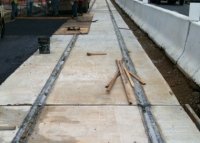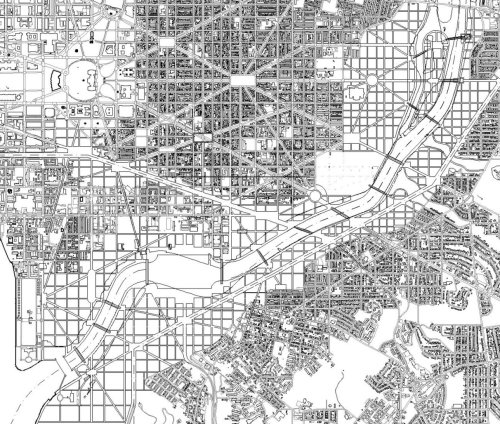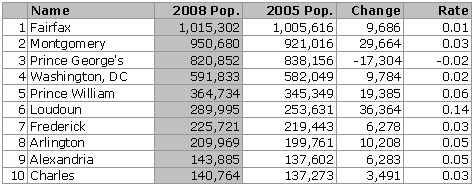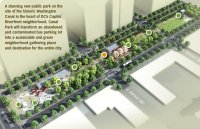|
Special Features





Image Libraries


|
|
Blog
After writing the previous blog post about the move-up of the H Street streetcar, I sent DDOT a message asking about the schedule. This was their response:
“Our official target date is still late 2012 for Anacostia, but we are working to accelerate that line as well as H/Benning.”
No word on just how much acceleration is possible, but this could mean that by 2012 we’ll have two operating streetcar lines in the city. Wouldn’t that be awesome.
Average Rating: 4.4 out of 5 based on 219 user reviews.
October 15th, 2009 | Permalink
Tags: transportation

|

Streetcar tracks in the ground on H Street. Photo by J-Blue. |
Big news on DC streetcars today. According to a story in the Business Journal, DC Councilman Tommy Wells has convinced Mayor Fenty to focus on getting the H Street streetcar operational as soon as possible, leaping it ahead of Anacostia, which was slated to be first.
The major issue with H Street is how to power the rail cars. Being inside the L’Enfant City, H Street is encumbered by the law restricting overhead wires. There are some alternatives out there, but they’re more expensive and our existing vehicles aren’t set up to use them. Wells says he is planning to introduce a bill that would allow streetcar wires on H Street later this year, but Congress may not allow it. In that event, at least we’ll know we have to find an alternate.
As far as I know there isn’t a schedule for when streetcars might begin running on H Street. It probably depends on the power issue. Hopefully this realignment of priorities results in faster implementation of light rail in the District. One thing we don’t need is yet another delay. In September DDOT boss Gabe Klein said the Anacostia line would open in 2012, with an initial segment possible earlier. It would be a real shame if 2012 comes and goes and we still don’t have streetcars running anywhere in the city.
As for the wire issue, I think the compromise solution suggested by GGW is very reasonable. There may be good reasons to prohibit wires on Pennsylvania Avenue or in front of the National Mall, but every street inside the L’Enfant City is not created equal. H Street is neither monumental nor particularly historic; there’s no good reason it ought not have streetcar wires.
Average Rating: 4.5 out of 5 based on 256 user reviews.
October 15th, 2009 | Permalink
Tags: transportation

Tsarchitect and GGW have a cross-post up detailing and critiquing a plan by a group called Build DC to radically reinvent the Anacostia waterfront. The plan would introduce a fully urban street grid to both sides of the river, reclaiming for urban development land currently occupied by parking lots and empty fields. The plan would completely stitch together neighborhoods east and west of the river currently separated by a mile or more of wasteland. The river itself, which is wide but shallow, would be narrowed and channelized, with an elevated esplanade on each bank a la the Seine in Paris. Instead of the region’s forgotten and polluted stepchild, the Anacostia could be its crown jewel.
Obviously before such an ambitious plan were implemented a lot of details would have to be worked out. Is it really necessary to narrow the river, or bury every rail line? How would we pay for it? So on. These aren’t easy questions, but this isn’t a plan that’s supposed to be implemented tomorrow; it’s a 100 year vision for gradual change. We can start with the District government’s own Anacostia Initiative and go from there.
I’ll leave the more detailed explanation and debate to the excellent post already up at GGW and Tsarchitect, but the long story short is that this plan would make the city drastically better, in just about every way. I hope I live to see something like it implemented.

Build DC’s proposed street grid for the Anacostia. Yes please.
Average Rating: 4.5 out of 5 based on 234 user reviews.
October 15th, 2009 | Permalink
Tags: master planning

Greater Greater Washington has recently been hosting a debate about the need for a more direct rail connection to Dulles Airport. Spencer Lepler has argued that Virginia should convert the W&OD trail to an interurban rail line providing express non-stop service to downtown Washington. In rebuttal, Matt Johnson has argued that the Silver Line is enough of an investment in the Dulles corridor, and that converting the W&OD trail would be impractical.
What if they’re both right?
There is a solution out there that would provide faster service to Dulles without requiring much new infrastructure: A skip-stop express. It would be possible for Metro to run express trains along the (soon to be) existing Silver Line route by simply not stopping at every station, as potentially illustrated here:

A potential skip-stop express to Dulles Airport. East of Rosslyn all trains would serve all stops, but west of Rosslyn the express would only stop at the highest-ridership stations.
True, there will be no express tracks on the Silver Line, but while that makes a skip-stop service more operationally difficult, it doesn’t necessarily preclude the option entirely. If cross-over tracks are provided at every station, local trains can pull onto the opposite track at any station in order to let express trains pass by. Doing so requires careful coordination and alert train operators, but it’s completely possible. The downside is that trains going in the non-peak direction may have to stop and wait between stations if a local has crossed over onto the opposite track, but it could be that the added peak-direction efficiency is worth the trade-off.
If such operational difficulties can be overcome, a skip-stop express would be a true win-win for both Spencer and Matt. It would provide a quick connection to the airport and a faster ride downtown for outer suburbanites (freeing up seats on local trains for closer-in passengers in the process), but wouldn’t require the kind of massive new investment that a whole second rail line would need. In fact, such a train would in all likelihood be even faster than a W&OD route, since it wouldn’t have to travel all the way south to Alexandria before crossing the Potomac.
If Metro can do this the region would get all the benefits of an express line without any of the headaches associated with the W&OD route. It would be a cheaper, faster, better alternative. There would be little downside.
Cross-posted to Greater Greater Washington.
Average Rating: 4.6 out of 5 based on 255 user reviews.
October 13th, 2009 | Permalink
Tags: featured post, proposal, transportation

Readers may notice that a couple of things on the home page are a little different. I’ve made some minor tweaks: The graphic for newest feature has been replaced by a script that calls up a random image for any one of the features, I’ve added a category tag listing at bottom right, and the URL icon has been replaced.
I may make some additional tweaks soon, including a new (non-slow) script to display the newsfeed, but the overall look of the site will remain more or less the same.
Average Rating: 4.5 out of 5 based on 166 user reviews.
October 12th, 2009 | Permalink
Tags: site

When Kensington banned children from a public park and tried to extort money from their school earlier this week, it was an acute case of heartless cruelty. It was also an (admittedly extreme) example of the exclusivity ingrained into much of suburban thinking that can seriously degrade community health.
It’s easy to understand how communities built on the notion of escaping from the unruly city can be so xenophobic, but that doesn’t mean it’s OK that they are. A community that values its serenity or pocketbook so much that it forgets the needs of its constituents isn’t much of a community. College students, skateboarders, high school marching bands, and even (the horror) fifth-graders are all legitimate community members, with legitimate needs.
The next time the folks on the Kensington town council see a news story about obesity rates among children, or about the social apathy of a generation raised on video games and TV, they should remember the time they outlawed healthy, constructive, school-supervised outdoor play.
Average Rating: 4.9 out of 5 based on 238 user reviews.
October 9th, 2009 | Permalink
Tags: social

If you are reading this blog you are probably already aware of today’s story in the Post about how the taxpayer-funded DCUSA parking garage is so underused. GGW has covered it, Richard Layman has covered it, and it’s been all over Twitter.
I can’t say much that hasn’t already been said, but just to be on record: The simple fact here is that based on experiences with stores in more car-oriented areas planners assumed everybody would drive to DCUSA, while in actual practice most people don’t. Why? Because in a dense, walkable, transit-accessible city it is more convenient to use alternative modes.
When I lived in Ballston and wanted to go to Target, I rented a Zipcar and drove to the nearest one (at Seven Corners). Now that I live in Dupont and use the Columbia Heights Target, I could still get a Zipcar, but don’t. Why in the world would I? My normal routine is to hop any of the S buses on 16th Street. In the rare event I’ve got too large a load to comfortably carry, I hail a taxi.
I use the bus or very occasionally a taxi because they’re the easiest modes, not because of any anti-car dogma. And clearly, I’m not the only one.
Average Rating: 4.6 out of 5 based on 158 user reviews.
October 8th, 2009 | Permalink
Tags: transportation, urbandesign

|

Virginia’s first modern light rail vehicle. |
Norfolk is starting to take delivery of its light rail vehicles. Norfolk’s light rail line will be the first in Virginia since the closure of the last pre-war streetcars. It will go 7.4 miles through downtown Norfolk to the Virginia Beach city line. Construction is about half finished, with revenue service scheduled to begin next year. For more information, check RideTheTide.com.
Hat tip to Rebuilding Place in the Urban Space for the scoop.
Average Rating: 4.9 out of 5 based on 200 user reviews.
October 6th, 2009 | Permalink
Tags: transportation

Last week’s Top 10 TODs list was basically subjective. For today, how about something that can be supported using hard data:
Largest jurisdictions in the DC area, with growth since 2005

Interestingly, 20th Century sprawl champion Fairfax County – the only jurisdiction in the region with over a million residents – is now the slowest growing jurisdiction in the region, save for shrinking Prince George’s. A strong back-to-the-center movement is visible, as Arlington and Alexandria are both growing faster than any of the Beltway counties, and DC doing better than two out of the three. Even in real, non-percentage terms, more people moved into both Washington and Arlington than into Fairfax between 2005-2008.
Note: An earlier version of this post indicated that the District of Columbia was growing substantially faster. That information was incorrect. It didn’t reflect the 2006 census revision which increased the estimate for the District’s population. The census’ 2005 estimates page doesn’t indicate that the numbers are uncorrected, so I only discovered the error when checking against baseline data in the 2007 estimates. Apologies for any confusion or misdirected celebration.
Average Rating: 4.8 out of 5 based on 234 user reviews.
October 6th, 2009 | Permalink
Tags: top10

|

Canal Park, as proposed. |
Private sector development in the Navy Yard / Capitol Riverfront / Ballpark / Whatever-We’re-Calling-It neighborhood may have slowed to a crawl in the bad economy, but public work on the once-and-future hotspot continues. Last week the National Capital Planning Commission approved conceptual plans for Canal Park, a three-block esplanade one-third of a mile from Nationals Stadium. The plan will convert existing industrial uses into what will surely become the primary gathering place for residents living in the neighborhood.
The bad news is that the park is only partially funded. The DC planning office is backing 75% of the $18 million cost, but the non-profit running the show needs another $4.5 million before it can build.
This is a great example of a park proposed to be the bona-fide active center of a neighborhood, as opposed to a reserve against development. I look forward to enjoying it some afternoon in a summer or two.
Average Rating: 4.9 out of 5 based on 165 user reviews.
October 5th, 2009 | Permalink
Tags: urbandesign

|
Media





Site
About BeyondDC
Archive 2003-06
Contact
Category Tags:
Partners
|



















